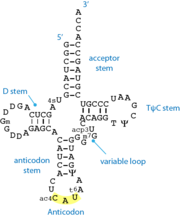Transfer RNA (tRNA)
From Proteopedia
(Difference between revisions)
| Line 1: | Line 1: | ||
<StructureSection load='' size='450' side='right' scene='1ehz/1ehz_default/3' caption=''> | <StructureSection load='' size='450' side='right' scene='1ehz/1ehz_default/3' caption=''> | ||
| - | [[Image:TRNA.png| | + | [[Image:TRNA.png|left|thumb|Standard 2D cloverleaf structure of tRNA. The shown example is methionine-specific tRNA from ''E.coli'' ]] |
'''tRNA''' or '''transfer RNA''' is stable, structured RNA present in all living cells. tRNA participates in the process of protein [[translation]] by the [[ribosome]]. Varying tRNA molecules carry a specific amino acid esterified on their 3'-OH group (the acceptor end). They also carry a specific triplet sequence, the '''anticodon''', which pairs with its complementary '''codon''' on the messenger RNA, within the ribosome. | '''tRNA''' or '''transfer RNA''' is stable, structured RNA present in all living cells. tRNA participates in the process of protein [[translation]] by the [[ribosome]]. Varying tRNA molecules carry a specific amino acid esterified on their 3'-OH group (the acceptor end). They also carry a specific triplet sequence, the '''anticodon''', which pairs with its complementary '''codon''' on the messenger RNA, within the ribosome. | ||
| Line 30: | Line 30: | ||
Once aminoacylated, tRNA associate with the elongation factor EF-Tu (bacteria) or EF1 (eucaryotes) complexed to GTP. These ternary complexes can then be recruited to the ribosome, where they go to the A-site. If a cognate codon-anticodon interaction is formed, translation can proceed, the aminoacid is incorporated within the polypetide chain and eventually, the deacylated tRNA is release for another aminoacylation-deacylation cycle. | Once aminoacylated, tRNA associate with the elongation factor EF-Tu (bacteria) or EF1 (eucaryotes) complexed to GTP. These ternary complexes can then be recruited to the ribosome, where they go to the A-site. If a cognate codon-anticodon interaction is formed, translation can proceed, the aminoacid is incorporated within the polypetide chain and eventually, the deacylated tRNA is release for another aminoacylation-deacylation cycle. | ||
</StructureSection> | </StructureSection> | ||
| + | __NOTOC__ | ||
==3D Structures of tRNA== | ==3D Structures of tRNA== | ||
===Free tRNA=== | ===Free tRNA=== | ||
Revision as of 07:24, 30 July 2013
| |||||||||||
3D Structures of tRNA
Free tRNA
yeast phenylalanine tRNA
human lysine tRNA (primer of HIV1 reverse transcription)
yeast aspartic acid tRNA
E. coli initiatior methionine tRNA
tRNA fragments
Complexes with aminoacyl-tRNA synthetases
Complexes with elongation factors
Complex with RNAse P
Complexes with the ribosome
See Also
References
- ↑ Motorin Y, Helm M. tRNA stabilization by modified nucleotides. Biochemistry. 2010 Jun 22;49(24):4934-44. PMID:20459084 doi:10.1021/bi100408z
Reference for the structure
- Shi H, Moore PB. The crystal structure of yeast phenylalanine tRNA at 1.93 A resolution: a classic structure revisited. RNA. 2000 Aug;6(8):1091-105. PMID:10943889
Proteopedia Page Contributors and Editors (what is this?)
Karsten Theis, Wayne Decatur, Michal Harel, Frédéric Dardel, Ann Taylor, Joel L. Sussman, Alexander Berchansky
Categories: Trna | Topic Page | Translation | Modification | RNA | Amino acid

